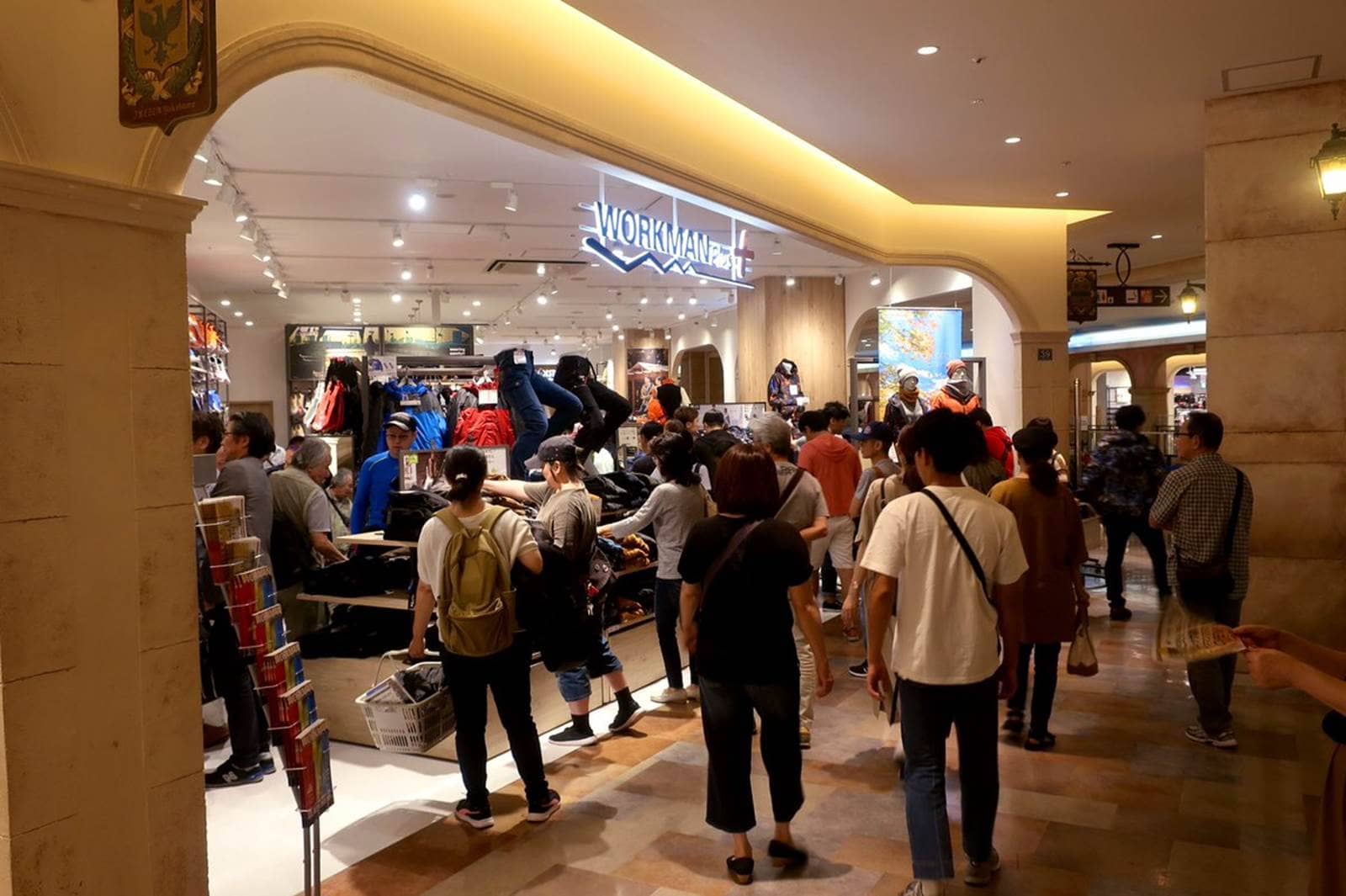The Workman Brand
As Uniqlo Loses its Luster, Hip Workman Workwear is the New Craze

Source:Twitter@ワークマン/WORKMAN Plus【公式】
Forever 21 has declared bankruptcy, and the Japanese brand apparel empire Onward Group has announced that it will close 20 percent of its outlets around the globe. Meanwhile, The Workman brand has become hugely popular, posting new revenue records for eight years in a row.
Views
As Uniqlo Loses its Luster, Hip Workman Workwear is the New Craze
By Yi-yun ShihFrom CommonWealth Magazine (vol. 684 )
American fast fashion retail chain Forever 21 has declared bankruptcy, and the Japanese brand apparel empire Onward Group has announced that it will close 20 percent of its outlets around the globe. Bucking the trend in the embattled fashion industry is a vendor of what was once regarded rather unfashionable blue-collar workwear. The Workman brand has become hugely popular, posting new revenue records for eight years in a row. Already the work clothes retailer boasts more outlets in Japan than ubiquitous retail chain Uniqlo. How did this specialty store for workers apparel manage to successfully cross over into the fashion mass-market, seizing a blue ocean market virtually without facing competition?
At the Workman fall fashion show in Tokyo’s Shibuya Ward in early September, the models on the runway were exposed to an artificial storm with heavy rain. Unfazed, the models, dressed in waterproof clothing, weathered the harsh conditions, the men swinging forward along monkey bars, and the women facing the elements smiling and confident.
Workman is not only causing a tempest on the runway but is also taking the entire Japanese fashion market by storm.
Last August, Workman, founded as a blue-collar worker clothier almost 38 years ago, opened its first outlets in shopping malls, challenging the established fashion retailers. Originally, the company had set an annual revenue target of 120 million yen (about NT$35 million), but much to everyone’s surprise, the annual target was reached in just three months. Consequently, the annual target was tripled for the year.\
 Source: Twitter@ワークマン/WORKMAN Plus【公式】
Source: Twitter@ワークマン/WORKMAN Plus【公式】
In the first quarter of this year, Workman posted an after-tax profit worth NT$1 billion, up 50 percent year-on-year. On September 25, when the news broke that Forever 21 was going bankrupt, Workman shares soared to a new high, so that the company, which is capitalized at just NT$500 million, hit a market value of NT$180 billion.
How is Workman bucking the downward trend in the embattled fashion industry?
“We provide all kinds of very practical ‘functionality’ for everyday life,” notes Tomoyuki Hayashi, manager with the Workman Business Planning Department. As Hayashi answers our questions, he grabs a bottle of mineral water and splashes its content directly on a jacket. The water rolls off the fabric in thick pearls without permeating it. “Your clothing won’t get dirty if you accidentally knock over your beverage,” remarks Hayashi, underlining that water-repellent functionality isn’t just handy in heavy rain.
Alongside rising demand for outdoor clothing caused by the recent fitness and camping boom, “functional” fabrics, which are windproof, waterproof, extremely elastic or insulate against cold temperatures, have helped Workman successfully make inroads into the mass market. On top of that, Workman clothes usually come at one third of the price of branded sports and outdoor wear, tempting many consumers to give them a try.
 Source: Twitter@ワークマン/WORKMAN Plus【公式】
Source: Twitter@ワークマン/WORKMAN Plus【公式】
This September, Workman released a mix-and-match guide that features photographs of Workman outfits that 92 consumers had posted on their Instagram pages. Among these, one user called “Workman girl” donned an androgynous jacket in a fashionable way, as if she was posing for a glossy women’s magazine. Clearly, Workman has managed to shed its former image of selling rustic, unmodern outfits that are a “fashion disaster.”
Shrinking Target Market Creates Opportunity for Transformation
Founded in 1980, Workman originally specialized in work apparel, accessories and corporate uniforms. Its stores opened at 7 a.m. so construction workers could stock up on workwear and gear before they went to work. They put just-purchased work shoes on right away and tossed the old ones in the recycling bin. The Workman store was the workman’s convenience store.
But in the wake of the financial crisis of 2007-2008, the number of construction projects in Japan plummeted, and given the downturn it was foreseeable that Workman’s traditional clientele of craftsmen and blue-collar laborers would shrink markedly. Moreover, Japan faced a severe shortage of skilled workers (Read: Japan’s Workforce Will be 20% Smaller by 2040). In a bid to attract the younger generation to the field, the de facto ban on bright colors began to be lifted. While white and gray were previously the dominant colors, brightly colored work clothes were now allowed in the workplace.
Workman took advantage of the opportunity to implement change. In 2013, the apparel retailer released brightly colored pant-shirt combinations for construction workers that were water resistant and insulated against the cold. Quite unexpectedly, the hardy combinations, which sold at less than NT$2000, proved highly popular with outdoor activity lovers such as anglers and motorcycle riders. Word of mouth led to astonishing sales of 50,000 sets per month.

Source: Twitter@ワークマン/WORKMAN Plus【公式】
Professional-grade functionality, which had passed the test during longtime use in the craftsman’s workplace, subsequently became a hot item in “unexpected fields”.
A hooded shirt and gloves made of flame-retardant cotton, typically worn by welders, have become essential gear for camping enthusiasts who like to cook on a campfire. Slip-resistant rubber boots normally used in commissary kitchens were snatched up by pregnant women who wanted footwear with a good grip. Dog owners went for the water-repellent, windproof work jackets to be able to walk their pets even in heavy rain without getting soaking wet. Workwear with inbuilt cooling fans, originally designed for workers engaged in physical labor in the sweltering summer heat, were readily adopted by ordinary consumers such as parents watching their kids play from the stands and spectators at other outdoor events.
“This August, sales of clothing with inbuilt cooling fans jumped nine-fold year-on-year,” says Hayashi. What used to be blue-collar workwear has meanwhile become casual wear for the average consumer. Demand for apparel with built-in fans is expected to soar among spectators at next summer’s Olympic Games in Tokyo.
To further shed its “special for the craftsman” image, Workman founded its own private brands, which are sold through newly launched Workman Plus stores. The new chain sells around 320 items of apparel and accessories geared toward the consumer market.
In the apparel retail market, Workman falls into the high-functionality, low-price segment, a market estimated to be worth 400 billion yen (about NT$120 billion) in Japan. Apart from major competitor French outdoor wear retail chain Decathlon, which opened its first store in Japan earlier this year, Workman navigates this blue ocean market virtually uncontested.
Have you read?
♦ Why is Uniqlo Opening Stores in Zara’s Territory?
♦ How Taiwanese Bubble Tea Conquered Japanese
♦ 10 Taiwan-made Hit Products in Japan
How Does Workman Keep Competitors Out?
First, Workman places orders of at least 100,000 pieces for a single item.
And since the focus stays on functionality, the retailer is immune to short-lived fashion trends. As a result, it does not run the risk of accumulating inventory of items that have “gone out of fashion”. Orders start at around 100,000 pieces, and for classical, long-selling indoor workwear, a single order can reach 3.5 million sets. Suppliers are mainly based in China, Myanmar, Vietnam and other parts of Southeast Asia.
“Clothing that is left over from the current season will be sold alongside the new clothes of the same model in the following year,” explains Hayashi.
Workman has also become a bastion hard to take by its competitors because its pricing strategy defies conventional industry practice.
Fast fashion vendors also pursue a low-price strategy. But since a gross profit margin of more than 60 percent is required to ensure sufficient net profit, the purchase price must not account for more than 30 percent of the end consumer price.
In contrast, Workman calculates with a gross profit margin of less than 40 percent, which means that the retailer can afford to purchase an item that sells at a NT$1000 price tag for around NT$600, about twice as much as its competitor can pay. In other words, at Workman the price-performance ratio is better as customers can get higher quality clothing for their money.
“Because we set a very low profit, we have hardly any room for discounts,” remarks Hayashi. Instead, Workman advertises “the lowest prices every day,” thus saving on administrative costs for special campaigns. For the past four years in a row, Workman has posted an operating profit ratio of above 20 percent.
Quoting retail industry analyst Taketo Yamate, Japanese economic daily newspaper Nihon Keizai Shimbun wrote that Workman uses a unique approach to create valuable products that it can sell at a low price and to clearly position its brand, therein extremely resembling Uniqlo, which emerged in the latter half of the 1990s.
Workman plans to expand the number of its outlets to 1,000 by the year 2025, clearly going against industry trends. Other fashion brands become increasingly conservative in their store expansion strategies and shift investment to e-commerce platforms. In the future, Workman will have ample opportunity to set its sights even higher beyond its current market by attracting an increasing number of “Workman girls” with more stylish designs and by entering the children’s wear segment and markets overseas.
Translated by Susanne Ganz
Edited by TC Lin, Sharon Tseng












